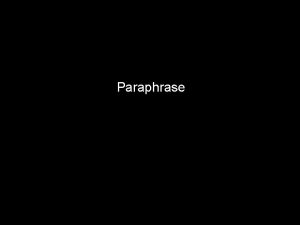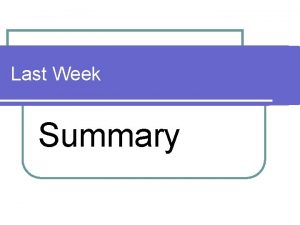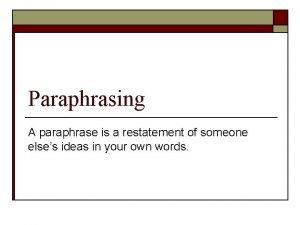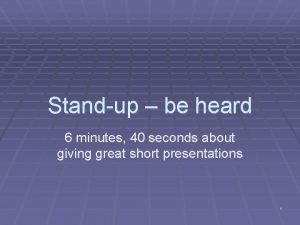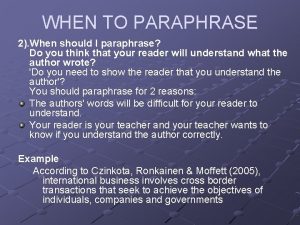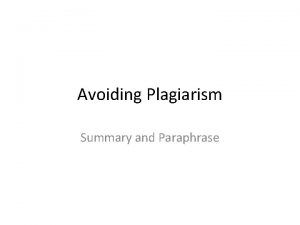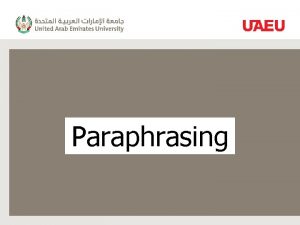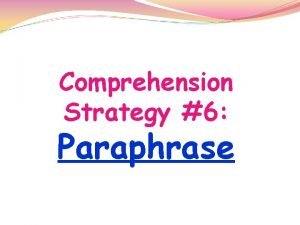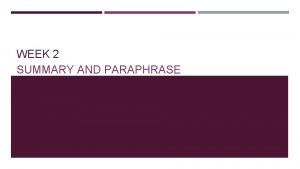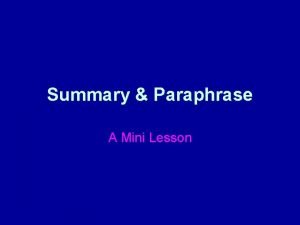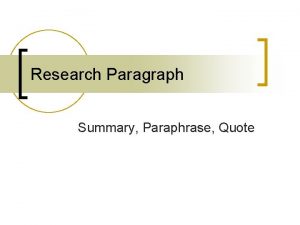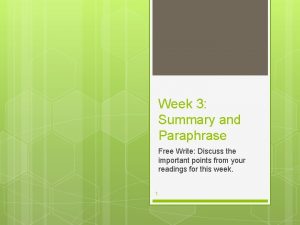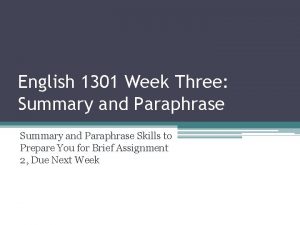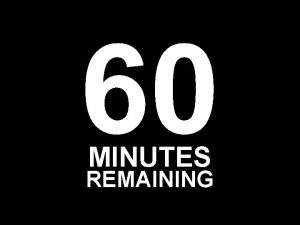Week 3 Summary and Paraphrase Freewriting 5 minutes



















- Slides: 19

Week 3 Summary and Paraphrase

Freewriting (5 minutes) Who: John Smith What: Auto Theft Where: Parking Garage When: September 7, 2014; 2: 31 a. m. How: ? Given these facts, pretend that you are a detective writing a report for this crime. (I will collect these and grade them. )

Group up and discuss… (5 min) �How does it begin? Where does it end? �What types of details did you find yourself adding? Why? �What details did you omit? Why? �What kind of words did you choose? �What tone did you take? �How did you order your information? �How did you know how to write like a detective?

Rhetoric �The art of persuasion. �Choosing how to express your meaning is every bit as important as the message itself. �Every time you go to write anything (or open your mouth), whether actively conscious of the purpose or not, you are making decisions about which words to use and what tone to establish as you order your thoughts based upon what is appropriate for your intended audience in that context. �You already possess these rhetorical skills.

Housekeeping �A few of you have not yet logged into Raider Writer. �You should have your BA 1’s back. Thoughts? Concerns?

BA 1 Issues �Remember to use paragraphs. �Make sure to clearly answer each question. �Always go back and read what you wrote. Revise and proofread. �Don’t try to write like someone else, but consider your audience and your purpose.

Paraphrase Summary �Putting a passage into your own words. �Putting the main ideas into your own words. �A series of restatements about an article, essay, etc. �Each restatement works together as a whole. �A summary is much shorter than the original work. �This is a broad overview of the original work. �Must have a works cited. � Usually a shorter piece of text. �The length of the restatement can be as long or longer than the original. �Must have a works cited. �Paraphrasing is a fundamental part of a summary.

Summary �First, read the text. �Then, read it again. This time take notes. What is thesis? What is the topic sentence for each paragraph? Is this topic repeated? �Write sentences based on your notes. �Summarize the argument, not the narrative (story).

The Lion King �http: //www. fandango. com/thelionking_51667/plotsu mmary �https: //www. youtube. com/watch? v=DFt. Bjc 1 dz 7 w

Frozen �https: //www. youtube. com/watch? v=Zb 5 IH 57 Sor. Q

Movies… �With your group, summarize a movie that you have all seen. �Write down your summary. You will read it to the class.

Brief Assignment 2 �Description, Part One, Article Summary �The following articles are located in Ch. 16 of your textbook. To complete your article summary, select one of the articles from the list below. Your summary of an article should follow the summary writing guidelines discussed in Section 12 f 3. �Articles to summarize (all from First-Year Writing): � “The New Sovereignty, ” Shelby Steele 450 � “My Pedagogic Creed, ” John Dewey 460 � “The American Scholar, ” Ralph Waldo Emerson 468

Tips for BA 2 �Summarize the argument, not the narrative. �Do NOT address the authors by their first names. �Remember not to use details in your summary. It is intended to be a brief overview of what the text is about. �When paraphrasing, do not copy the author’s words or style. You will lose points if your paraphrase is too close to the original. �Start considering who the audience is and what the purpose is. �Summary should be at least 170 words.

Tips… �Read the article and then read it again. �Try to go through the article and highlight the main points of the argument. Try to pull the main idea out of each paragraph and put it into your own words. Then, put all of these together to form your summary. �Brief Assignment 2 is due Friday at 11: 59 p. m. Turn this in on time.

Part 2. �Paraphrase a brief but complex passage from the same text. Your goal in this assignment is to restate the ideas of the passage in your own words and do so in a way that is readable and understandable. To complete this assignment choose one passage selected by your instructor that is part of the text you summarized and paraphrase that passage. Identify the page number and paragraph number of the original passage (i. e. p. 205, paragraph 1) above your paraphrase so that your instructor can easily see the changes you have made to express the ideas of the passage in your own words.

Passages to Paraphrase. �Steele – paragraph 26 (“In a liberal democracy…”) �Dewey – paragraph 5 (“With the advent of democracy…”) �Emerson – paragraph 14 (“Yet hence arises a grave mischief. ” �You do not have to paraphrase the entire paragraph. �Pick 2 -3 sentences from the paragraph and paraphrase them. �Points will be deducted for not using one of the above passages.

Paraphrasing Tips… �Read the paragraph several times and then put the book away. Do not look at the original source while you are paraphrasing. �Do not use a thesaurus. �Use your own words. �Simplify the passage, but make sure you include all of the information.

Works Cited �Last name, First name. “Title. ” Source publication. Issue. Number (year): Page numbers. Rpt. in Reprinted publication. Ed. First name Last name. City: Publisher, year. Page numbers. Print.

Homework… �Write: � An email to your parent/guardian. � A letter to the President of Texas Tech. � An email to your professor. � A letter/Facebook post to your friend. �Do NOT send these. Write them down and bring them to class. � Each should be one paragraph. You get to decide the topic/purpose of each letter. � Read “The Myth of Helplessness” (p 477). Answer the questions “Looking at Rhetoric” on page 483. � Due next Monday.
 1 minute and a half
1 minute and a half Week by week plans for documenting children's development
Week by week plans for documenting children's development Heresy of paraphrase
Heresy of paraphrase Last week summary
Last week summary Romeo and juliet in plain english
Romeo and juliet in plain english Students frequently overuse direct quotation
Students frequently overuse direct quotation Poem paraphrase examples
Poem paraphrase examples Romeo and juliet prologue paraphrase
Romeo and juliet prologue paraphrase Romeo and juliet starter
Romeo and juliet starter Confirm your email now and get 5 minutes as a gift!
Confirm your email now and get 5 minutes as a gift! 6 minutes and 40 seconds
6 minutes and 40 seconds 3 minutes and a half
3 minutes and a half Paraphrase zitieren
Paraphrase zitieren Why paraphrase
Why paraphrase Iparaphrase
Iparaphrase Tpcastt poem example
Tpcastt poem example Nothing gold can stay alliteration
Nothing gold can stay alliteration The solitary reaper explanation stanza by stanza
The solitary reaper explanation stanza by stanza 14 line sonnet about summer
14 line sonnet about summer Sonnet 60 by shakespeare
Sonnet 60 by shakespeare


